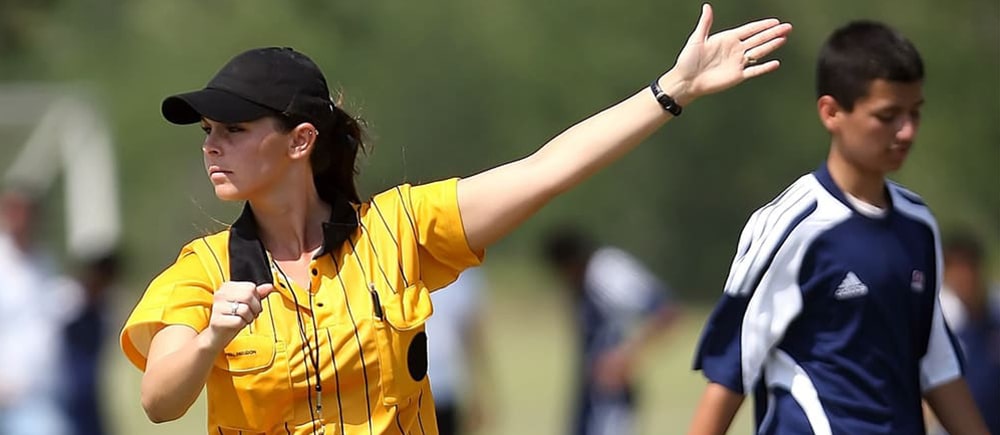A typical soccer game is played for 90 minutes, comprising of two 45 minute halves. There can also be time added on at the end of each half, which is referred to as stoppage time.
What is stoppage time?
Stoppage time (also known as injury time or added time) is additional time added on at the end of each 45 minute half. As play stops on numerous occasions during a match, the clock doesn’t stop. Therefore to cater for these delays during a match, soccer has stoppage time.
This additional time is roughly based on the duration of stoppages during that half. It’s common to see matches having 1-5 minutes of stoppage time, with time rounded up to the nearest minute.
Stoppage time is also in place to prevent players from wasting time by running down the clock to protect a lead. This behavior from players, however, is policed by the referee and is punished generally by the referee showing the player a yellow card.
Some of the most common types of stoppages in a match are:
- Injuries
- Substitutions
- Goal celebrations
- Bookings
- Dissent
- Penalty kicks
- Video review – Var (video assistant referee)
- Warnings
- Crowd disruption
- Equipment failure (goal netting, corner flag, flat ball)
- Pitch invaders
General stoppages in play such as goal kicks, corner kicks, and throw-ins are not taken into consideration for stoppage time unless the referee decides that the player has wasted time on purpose.
When a penalty shot is awarded in stoppage time, typically additional time is added to allow the penalty to be taken.
What are the rules of soccer stoppage time?
The soccer stoppage time rules according to FIFA’s Laws of the Game, indicate that referees are urged to use their own discretion when applying stoppage time. In particular, FIFA’s Law 7 indicates:
Allowance is made by the referee in each half for all time lost in that half through:
- Substitutions
- assessment and/or removal of injured players
- wasting time
- disciplinary sanctions
- stoppages for drinks (which should not exceed one minute) or other medical reasons permitted by competition rules
- delays relating to VAR ‘checks’ and ‘reviews’
- any other cause, including any significant delay to a restart
(e.g. goal celebrations)
Acting as the timekeeper, referees apply best practices when keeping track of stoppages, by allocating generic times for the more common breaks in play. For the more infrequent stoppages, referees keep track of these delays, along with assistance from the fourth official.
The generic times applied for common delays will result in the referee roughly allocating a duration of time such as 30 seconds, for substitutions, goals, and cards which is used as a general guide when calculating stoppage time.
When nearing towards the end of regular playing time for the half, the referee informs the fourth official on the sidelines how much stoppage time has been calculated. The fourth official then holds up a sign (clock board) indicating how much stoppage time has been allocated for the half, which informs the players, coaches, and fans.
What about time delays during stoppage time?
Time delays also do occur during stoppage time. As the end of the match approaches, players on the winning team are prone to wasting time. The referee can again use discretion to further add more time during the stoppage time period if he or she feels players are deliberately wasting time.
So when asking yourself how long does a soccer game go for, you’ll need to factor in 90 minutes of regular time, plus any stoppage time and additional delays.
How long is half time in soccer?
Half time in soccer is an interval of approximately 15 minutes. According to Law 7 of the FIFA Laws of the Game, the halftime interval must not exceed 15 minutes.
Half time allows the players and officials to have a well-earned rest and refuel their bodies. Players on each team will listen to further instructions from their coaches and re-group in preparation for the second half.
When returning to the field for the second half, the teams change ends and face the opposite direction from the first half. This is to ensure each team has the benefit of playing in both directions and equally experience the same conditions, such as difficult weather conditions including wind, sun glare, and directional rain. There can also be conditions with the field that may affect one half of the field more than the other, such as bumpy, muddy and wet playing surfaces.
How long is a world cup soccer game?

A World Cup soccer game is played for 90 minutes, plus stoppage time which usually varies from 1-5 minutes.
If the match is in the knockout round of the tournament and the teams are level at the end of stoppage time, 30 minutes of extra time is added to the match. If the game still remains tied at the end of extra time, the teams will then play in a penalty shootout to determine the winner of the game.
Group stage
A World Cup group stage match is similar to other standard matches where the game is played for 90 minutes, plus added on time for stoppages during the match.
World Cup group matches are similar to other major tournament group stages, where 4 teams are allocated to each group and play in a round-robin tournament with all teams in the group. After all teams in the group have played each other, the top two teams with the most points advance to the knockout stage.
Knockout stage
A World Cup knockout stage match is played for 90 minutes, plus stoppage time. If teams remain tied after the regular playing time, extra time is added to determine a winner.
How long is extra time in soccer?
Extra time is played for 30 minutes, consisting of two 15 minute halves. It is introduced generally into a tournament knockout match when the game remains tied after regular playing time.
Extra time provides both teams with more playing time and the opportunity to find a winning goal. After the first 15 minute half is finished, the half time break is brief, with the teams required to change ends and commence the second half of extra time without delay.
If matches remain tied after 30 minutes of extra time, then the game will go to penalty shootouts.
Soccer penalty shootout
A soccer penalty shootout involves 5 penalty kicks from each team, with the team who has scored the most goals at the end is determined the winner of the match.
The coaches decide which 5 players from the team will be responsible for taking a penalty and in what order. If both teams score all five penalty kicks, then the penalty shootout moves into the next phase, known as sudden death.
This is where other players from the team are required to step up and take a penalty kick. If players from both teams continue to score in sudden death, penalty kicks will continue until one team misses and the other team scores.
Penalty kicks are the last resort to determine the winner of a match, with a lot of pressure on the players to score their penalty.
Conclusion
Although soccer games consist of two 45 minute halves, very rarely do they finish at 90 minutes. Several minutes of stoppage time is also typically added to a match, where referees use their own discretion and general best practices for establishing the duration of delays during a match.
Players often try to influence the clock by wasting time during a match, in an attempt to protect a winning lead. This type of behavior should be punished by the referee and the duration of the delays included as additional time at the end of each half.
There’s also the type of match to consider when determining how long a soccer match goes for.
Most tournament matches will have knockout stages, where matches move into 30 minutes of extra time when the teams are tied after regular time. Therefore with 90 minutes of regular time, plus stoppage time (typically 1 – 4 minutes), plus 30 minutes of extra time, this would result in more than 120 minutes of gameplay.
Penalty shootouts are introduced as the final option to determine a winner of the knockout match when both teams remain tied after extra time. There is no specific time allocated for this final phase of the game.
With the length of a standard soccer match typically going beyond 90 minutes and sometimes beyond 120 minutes in the knockout stages of a tournament, it’s become evident that players need to have great fitness levels in order to last the duration of a game.
Share
Related posts:
- What is the best age to start soccer?
 A guide to understanding the best age for kids to start playing soccer and how to go about getting kids involved in the playing the sport, ranging from…Read more.
A guide to understanding the best age for kids to start playing soccer and how to go about getting kids involved in the playing the sport, ranging from…Read more. - Why are soccer balls black and white?
 Black and white soccer balls were first used at the 1970 World Cup, with the Adidas ‘Telstar’ developed to be seen more clearly on… Read more.
Black and white soccer balls were first used at the 1970 World Cup, with the Adidas ‘Telstar’ developed to be seen more clearly on… Read more. - How big is a soccer field?
 Soccer fields do not have fixed dimensions. Soccer field dimensions can range between the specified minimum and maximum length and width… Read more.
Soccer fields do not have fixed dimensions. Soccer field dimensions can range between the specified minimum and maximum length and width… Read more.
ABOUT ME
Hi, I’m Steve. I started playing soccer at the age of 4 at my local soccer club. I developed a passion for the game at an early age that saw me go on to play soccer for 29 years. Soccer is a big part of my life and I want to share with you what I’ve learned along the way. Happy exploring!

